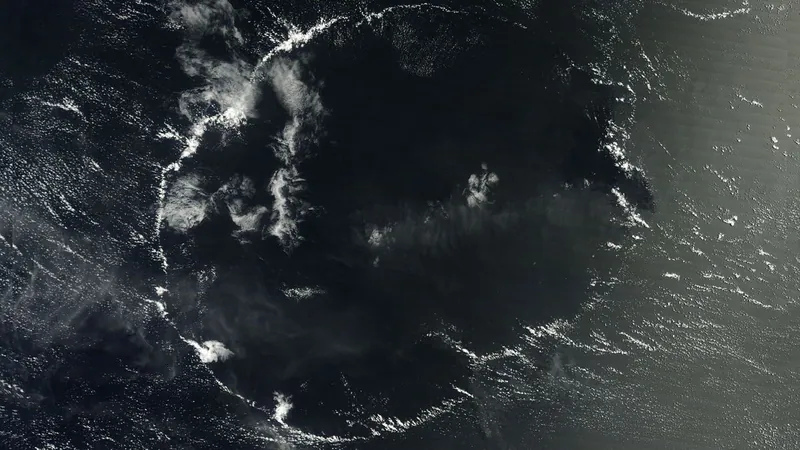
Stunning Satellite Discovery: A Gigantic Perfect Cloud Ring Emerges in the Pacific Ocean!
2025-04-01
Author: John Tan
Stunning Satellite Discovery: A Gigantic Perfect Cloud Ring Emerges in the Pacific Ocean!
In an extraordinary visual revelation from space, a gigantic and nearly flawless cloud ring has captured the attention of meteorologists and sky enthusiasts alike. Spotted over a decade ago, this captivating formation is located deep in the Pacific Ocean, an area more than a thousand miles southwest of the Hawaiian Islands.
The immense cloud ring spans an impressive 280 miles (450 kilometers) in diameter and was photographed by NASA's Terra satellite using its Moderate Resolution Imaging Spectroradiometer (MODIS). Although clouds that form circular patterns are not unheard of, finding one so isolated and in such a remote part of the ocean is exceptionally rare, according to experts from NASA's Earth Observatory.
This magnificent ring of cumulus clouds is structured through a phenomenon known as Rayleigh-Benard convection. This occurs when warmer air rises and cool air sinks in a cyclical pattern, creating distinct atmospheric dynamics. The cloud ring's particular formation is classified as a closed cell—one of two primary types of cloud cells. Closed cells form when cooler air encircles the edges of developing clouds, pushing the moist air upward to create these striking formations.
Cloud patterns typically exhibit geometric organization, usually presenting in hexagonal shapes accompanied by similar cells nearby. However, this singular cloud ring stands alone, defying the typical conventions of cloud groupings. Open-cell clouds, in contrast, display a lattice-like structure that appears more disorganized, often resembling honeycombs formed by rising warm air.
The cause of this lone cloud ring can likely be traced back to a region of warm air enveloping a small landmass or area of heated water, leading to an upsurge of buoyant air. As the warm air rises, it leads to the creation of cumulus clouds and possibly some light rain, which cools the air beneath. This cooling effect generates downdrafts that push the rain-cooled air outward, subsequently interacting with warmer surrounding air and giving rise to the distinctive ring shape.
Significantly, the cloud ring is situated just south of the Intertropical Convergence Zone (ITCZ), a critical low-pressure area near the equator characterized by intense thunderstorms and rainfall activity driven by trade winds. This geographical positioning likely contributed to the formation and dynamism of the cloud structure.
Adding to the visual spectacle, the ocean surface adjacent to the cloud ring exhibits a metallic sheen, a phenomenon known as sunglint. This occurs when sunlight reflects off the ocean's surface back toward an observer in space, transforming vast stretches of the sea into shimmering, mirror-like displays.
This remarkable satellite imagery not only showcases the awe-inspiring beauty of our planet but also highlights the complex interplay of atmospheric and oceanic processes. Scientists continue to study such formations to gain deeper insights into meteorological phenomena and climate patterns. What other secrets are hidden above and below the Earth's surface? The sky is the limit!


 Brasil (PT)
Brasil (PT)
 Canada (EN)
Canada (EN)
 Chile (ES)
Chile (ES)
 Česko (CS)
Česko (CS)
 대한민국 (KO)
대한민국 (KO)
 España (ES)
España (ES)
 France (FR)
France (FR)
 Hong Kong (EN)
Hong Kong (EN)
 Italia (IT)
Italia (IT)
 日本 (JA)
日本 (JA)
 Magyarország (HU)
Magyarország (HU)
 Norge (NO)
Norge (NO)
 Polska (PL)
Polska (PL)
 Schweiz (DE)
Schweiz (DE)
 Singapore (EN)
Singapore (EN)
 Sverige (SV)
Sverige (SV)
 Suomi (FI)
Suomi (FI)
 Türkiye (TR)
Türkiye (TR)
 الإمارات العربية المتحدة (AR)
الإمارات العربية المتحدة (AR)